Discrete Meta-Simulation of Silage Based on RSM and GA-BP-GA Optimization Parameter Calibration
Abstract
:1. Introduction
2. Material and Methods
2.1. Test Samples
2.2. Determination of Characteristic Parameters
2.2.1. Geometrical Characteristics
2.2.2. Water Content
2.2.3. Bulk Density
2.2.4. Friction Coefficient
2.2.5. Stacking Angle
2.3. Creation of the Simulation Model
2.3.1. Creation of the Particle Model
2.3.2. Steel Plate and Bottomless Steel Cylinder Model
2.3.3. Contact Model
2.3.4. Simulation Parameter Settings
3. RSM Tests
3.1. PB Tests
3.2. Steepest Climb Test Design
3.3. Central Combination Response Surface Test
3.4. Effect of Interaction Factors on Stacking Angle
3.5. Optimization of RSM Result Parameters
4. GA Optimization Based on the GA-BP Model
4.1. GA-BP Model
4.2. GA-BP-GA Parameter Optimization
4.3. Validation Test
5. Conclusions
- (1)
- Experiments determined the physical- and mechanical-property parameters of silage. In three layers, the geometric size distribution of the silage was >19 mm, 8 mm ≤ particle size ≤ 19 mm, and <8 mm in three layers, representing 13.86%, 47.53%, and 38.61% of the bulk, respectively. The bulk density and moisture content were 69.16% and 491.68 kg/m3, respectively. The average static friction coefficient between silage and silage was 0.465, while the average static friction coefficient between silage and steel was 0.367. The average rolling friction coefficient between silage and silage was 0.176, and the average rolling friction coefficient between silage and steel was 0.138.
- (2)
- The physical stacking angle test was conducted on silage using a universal material tension tester and the cylinder hoisting method. The derived stacking-angle images were processed using MATLAB and Origin software, the contour pixel point coordinates were extracted, and linear fitting was used to determine a stacking angle of 38.65°.
- (3)
- Establishing a discrete element simulation model based on the Hertz–Mindlin with JKR Cohesion contact model, the PB test and steepest climb test were used to screen the significant factors affecting the stacking angle, and the CCD test was used to optimize the values of the significant parameters further. The static friction coefficient between silage and silage was 0.498, the rolling friction coefficient between silage and silage was 0.196, and the static friction coefficient between silage and steel was 0.404. The measured simulated silage stacking angle was 40.0526°, with a relative error of 3.6% compared to the actual physical silage stacking angle.
- (4)
- The topology of the GA-BP regression prediction model was 3-7-1, and the GA heritage algorithm was used to discover the inverse function for the GA-BP regression model. The simulation yielded the optimal parameters: the static friction factor between silage and silage was 0.495, the rolling friction factor was 0.194, and the static friction factor between silage and steel was 0.42. The measured simulated stacking angle of silage was 39.151°, and the relative error with the actual stacking angle of silage was 1.3%, which was better than the relative error of RSM (3.6%). This indicates that GA-BP-GA is superior to RSM for parameter optimization in silage parameter calibration.
- (5)
- The study demonstrates that the discrete element method is a scientific and reasonable approach for the parameter calibration of silage. Furthermore, GA-BP-GA’s parameter optimization effect is better than RSM’s. The results of this study provide scientific data to support the simulation and analysis of silage. Building on these findings, the discrete element model of silage-related conveyors offers a theoretical basis for revealing the conveyor’s silage mechanism and optimizing the design of conveyor machinery and equipment.
Author Contributions
Funding
Data Availability Statement
Acknowledgments
Conflicts of Interest
References
- Zhang, L.; Chen, Z.; Yang, M.; Huang, H.; Ye, C. Analysis of spatial and temporal characteristics of maize production efficiency in China. J. Agric. Mach. 2018, 49, 183–193. [Google Scholar]
- Chu, T.S.; Yang, Z.L.; Han, L.J. Analysis of the satisfaction and dominance of crop straw fodder utilization in China. J. Agric. Mach. Eng. 2016, 32, 1–9. [Google Scholar]
- Chen, C.; Yang, Y.; Xie, G. Research on the development of straw resource management policy in China. J. China Agric. Univ. 2016, 21, 1–11. [Google Scholar]
- Opinions of the Ministry of Agriculture and Rural Affairs on accelerating the development of animal husbandry mechanization. In Xinjiang Agricultural Mechanization; Ministry of Agriculture and Rural Affairs of the People’s Republic of China: Beijing, China, 2020; pp. 39–41.
- Zeng, Z.; Ma, X.; Cao, X.; Li, Z.; Wang, X. Current status and outlook of the application of discrete element method in agricultural engineering research. J. Agric. Mach. 2021, 52, 1–20. [Google Scholar]
- Wang, X.; Li, P.; He, J.; Wei, W.; Huang, Y. Discrete element simulations and experiments of soil-winged subsoiler interaction. J. Agric. Biol. Eng. 2021, 14, 50–62. [Google Scholar] [CrossRef]
- Yuan, J.; Yin, R.; Liu, G.; Liu, X.; Mao, Z. Design and testing of a compound fruit tree planting machine with in-situ fertilizer mixer for digging and backfilling. J. Agric. Mach. 2021, 52, 110–121. [Google Scholar]
- Liu, P.; He, J.; Zhang, C.; Lu, C.; Zhang, Z.G.; Lin, H. CFD-DEM-based analysis and experiments on the movement characteristics of straw returning machine with broken stalks. J. Agric. Mach. 2020, 51 (Suppl. S1), 244–253. [Google Scholar]
- Zhang, T.; Liu, F.; Zhao, M.; Ma, Q.; Wang, W.; Fan, Q. Determination of physical parameters of corn stover contact with discrete element simulation calibration. J. China Agric. Univ. 2018, 23, 120–127. [Google Scholar]
- Zhang, F.; Song, X.; Zhang, X.; Zhang, F.; Wei, W.; Dai, F. Simulation and experiments on mechanical properties of corn straw kneading and crushing process. J. Agric. Eng. 2019, 35, 58–65. [Google Scholar]
- Wu, H.-A.; Wang, D.-C.; Gong, Z.-Q.; Zhang, X.M.; Wang, G.H. Optimized design of silage harvester throwing device based on EDEM. Chin. Dairy Cattle 2015, 18, 44–47. [Google Scholar]
- Coetzee, C.J.; Lombard, S.G. The destemming of grapes: Experiments and discrete element modelling. Biosyst. Eng. 2013, 114, 232–248. [Google Scholar] [CrossRef]
- Wang, X.; Yu, J.; Lv, F.; Wang, Y.; Fu, H. A multi-sphere based modelling method for maize grain assemblies. Adv. Powder Technol. 2017, 28, 584–595. [Google Scholar] [CrossRef]
- Gong, Y.; Wang, D.; Bai, X.; Qiu, S. A method for determining the parameters of the Burgers contact model for corn straw bulk particles. J. Shenyang Agric. Univ. 2019, 50, 306–313. [Google Scholar]
- Martina, C.L.; Bouvarda, D.; Shimab, S. Study of particle rearrangement during powder compaction by the Discrete Element Method. J. Mech. Phys. Solids 2003, 51, 667–693. [Google Scholar] [CrossRef]
- Huo, L.; Zhao, L.; Tian, Y.; Yao, Z.; Meng, H. Viscoelastic intrinsic modeling of biomass pellet fuel forming. J. Agric. Eng. 2013, 29, 200–206. [Google Scholar]
- Li, L. Experimental Study on Stalk and Leaf Separation Mechanism of Corn Stalks; Northeast Agricultural University: Harbin, China, 2014. [Google Scholar]
- NY/T 1881.2-2010; Test Method for Biomass Solid Forming Fuels Part 2: Full Moisture. China Agricultural Press: Beijing, China, 2010.
- NY/T 1881.6-2010; Test Methods for Biomass Solid-Forming Fuels, Part 6: Bulk Density. China Agricultural Publishing House: Beijing, China, 2010.
- Wang, L.; Fan, S.; Cheng, H.; Shen, Y.; Wang, J. EDEM-based calibration of swine manure contact parameters. J. Agric. Eng. 2020, 36, 95–102. [Google Scholar]
- Liu, W.; Xu, W.; Li, B.; Li, Y. Determination of rolling friction coefficient and EDEM simulation analysis. Mach. Des. Manuf. 2018, 9, 132–135. [Google Scholar]
- Liang, R.Q.; Chen, X.G.; Jiang, P.; Zhang, B.; Meng, H.; Peng, X.; Kan, Z. Calibration of the simulation parameters of the particulate materials in film mixed materials. Int. J. Agric. Biol. Eng. 2020, 13, 29–36. [Google Scholar] [CrossRef]
- Hao, J.; Wei, W.; Huang, P.; Qin, J.; Zhao, J. Calibration and experimental validation of discrete element parameters for oilseed sunflower seeds. J. Agric. Eng. 2021, 37, 36–44. [Google Scholar]
- Feng, J.; Lin, J.; Li, S.; Zhou, J.; Zhou, X. Calibration of discrete element parameters for particle mixing state in straw solid fermentation rotary cylinder. J. Agric. Mach. 2015, 46, 208–213. [Google Scholar]
- Horabik, J.; Molenda, M. Parameters and contact models for DEM simulations of agricultural granular materials: A review. Biosyst. Eng. 2016, 147, 206–255. [Google Scholar] [CrossRef]
- Liu, C.; Wang, Y.; Song, J.; Li, Y.; Ma, T. Discrete element modeling of rice seeds based on 3D laser scanning and experiments. J. Agric. Eng. 2016, 32, 294–300. [Google Scholar]
- Wen, B.; Wang, B.; Lu, X.C. Handbook of Metallic Materials; Electronic Industry Press: Beijing, China, 2013; p. 24. [Google Scholar]
- Luo, S.; Yuan, Q.; Gouda, S.; Yang, L. Parameter calibration of discrete element method for earthworm manure substrate based on JKR bonding model. J. Agric. Mach. 2018, 49, 343–350. [Google Scholar]
- Wang, W.; Cai, D.; Xie, J.; Zhang, C.; Liu, L.; Chen, L. Calibration of discrete element model parameters for dense forming of corn straw. J. Agric. Mach. 2021, 52, 127–134. [Google Scholar]
- Wang, B. Design and Optimization of a Self-Propelled Total Mixed Ration Preparation Machine; Shandong Agricultural University: Tai’an, China, 2022. [Google Scholar]
- Li, L. Analysis and Experimental Research on Mixing Mechanism of Drum-Type Grain Mixer; Northeast Agricultural University: Harbin, China, 2018. [Google Scholar]
- Yu, K.Q. Analysis and Experimental Research on the Mixing Mechanism of Rotor-Type Total Mixed Grain Mixer; Northeast Agricultural University: Harbin, China, 2015. [Google Scholar]
- He, Y.; Meng, Z.; Xu, H.; Zou, Y. A dynamic model of evaluating differential, automatic method for solving plane problems based on BP neural network algorithm. Phys. A Stat. Mech. Its Appl. 2020; 556, prepublish. [Google Scholar] [CrossRef]
- Bai, Y.L.; Xie, W.Y.; Zhao, M.T.; Zhou, K.M.; Fan, R.; Guan, T. MATLAB-based BP neural network for starch discrete element contact parameter calibration. Chin. J. Pharm. Sci. 2022, 57, 1268–1277. [Google Scholar]
- Yuan, S.C.; Jiang, X.Q. GA-BP neural network-based calibration of binocular cameras. J. Xi’an Univ. Archit. Technol. (Nat. Sci. Ed.) 2011, 43, 604–608. [Google Scholar]
- Jin, X.; Li, Y. Optimization of automotive wire harness cover stamping process based on BP-GA algorithm. Die Ind. 2022, 48, 17–21. [Google Scholar]
- Ding, X.; Li, K.; Hao, W.; Yang, Q.; Yan, F.; Cui, Y. Calibration of oilseed simulation parameters based on RSM and GA-BP-GA optimization. J. Agric. Mach. 2023, 54, 139–150. [Google Scholar]
- Gammoudi, N.; Mabrouk, M.; Bouhemda, T.; Nagaz, K.; Ferchichi, A. Modeling and optimization of capsaicin extraction from Capsicum a nuum L. using response surface methodology (RSM), artificial neural network (ANN), and Simulink simulation. Ind. Crops Prod. 2021, 171, 113869. [Google Scholar] [CrossRef]


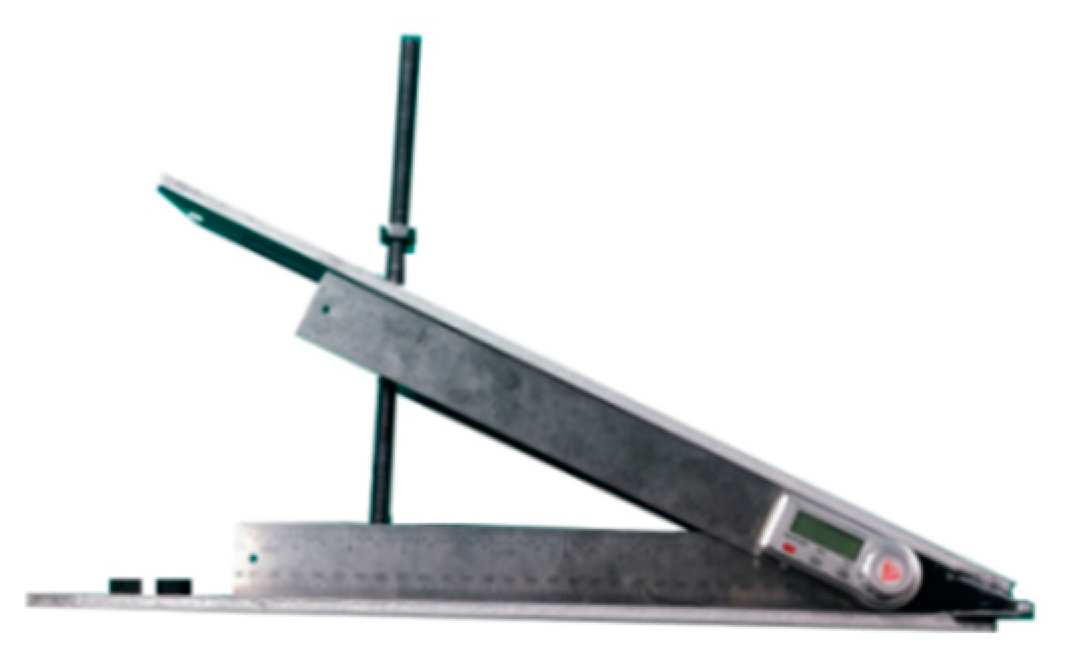

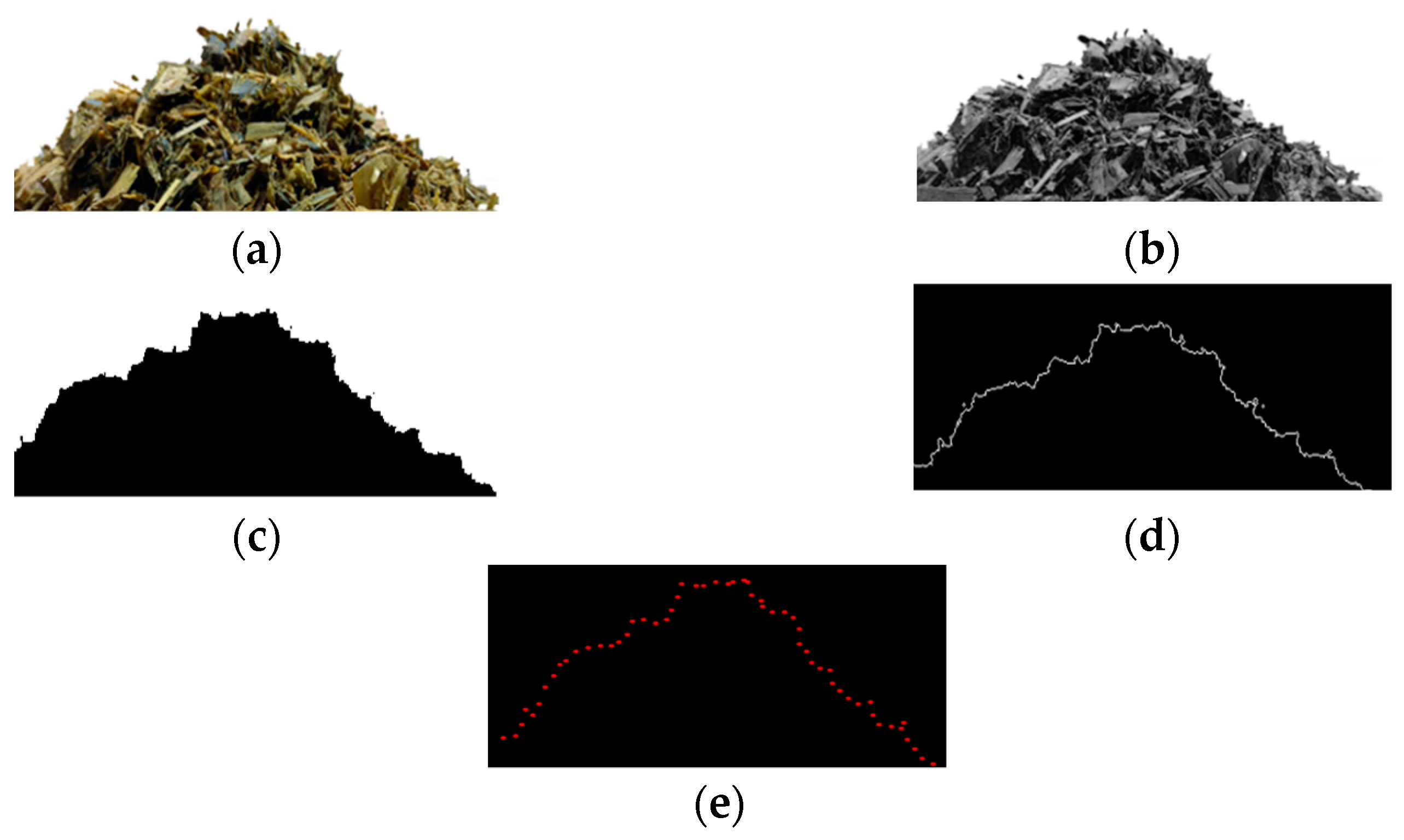


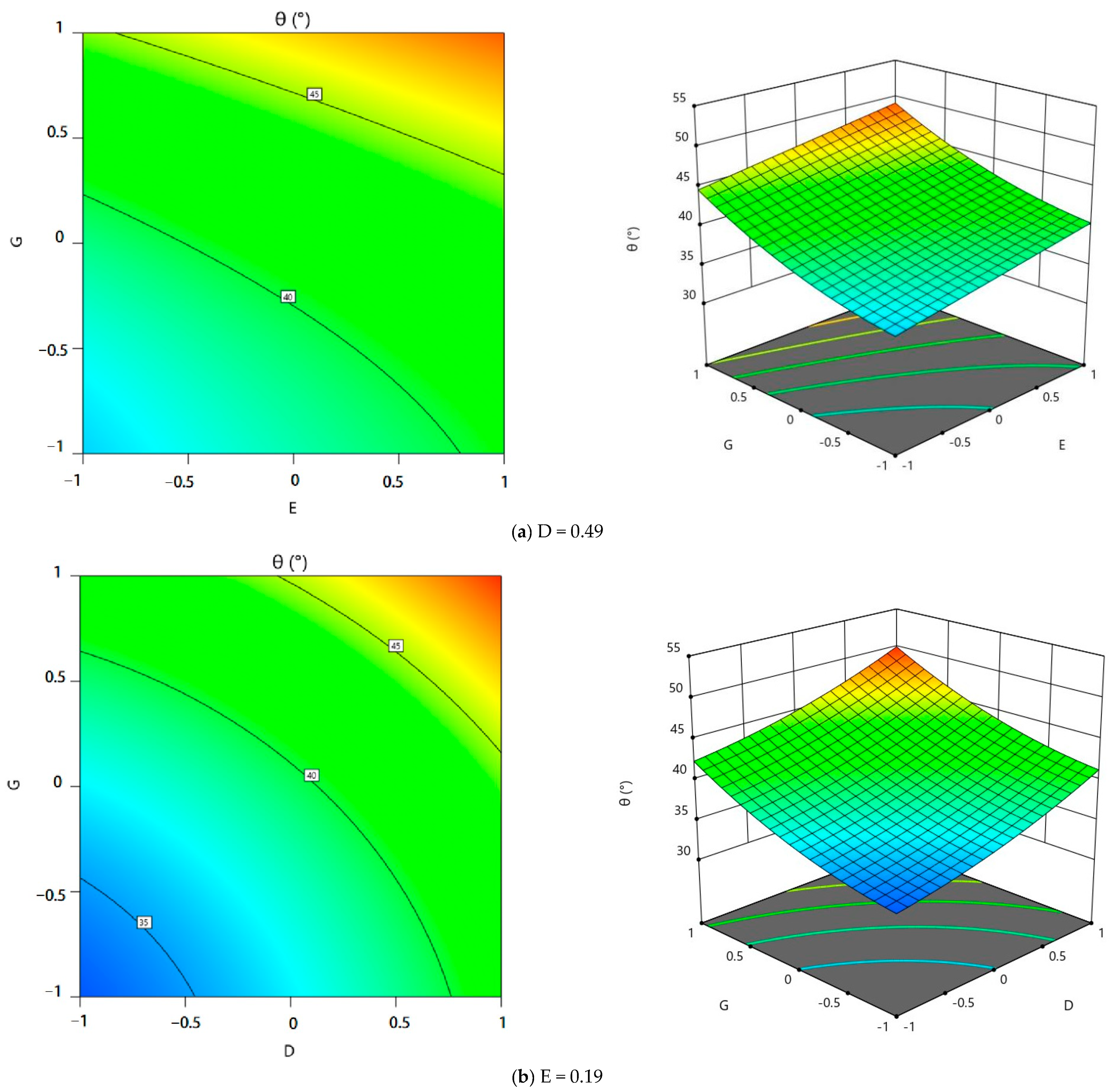
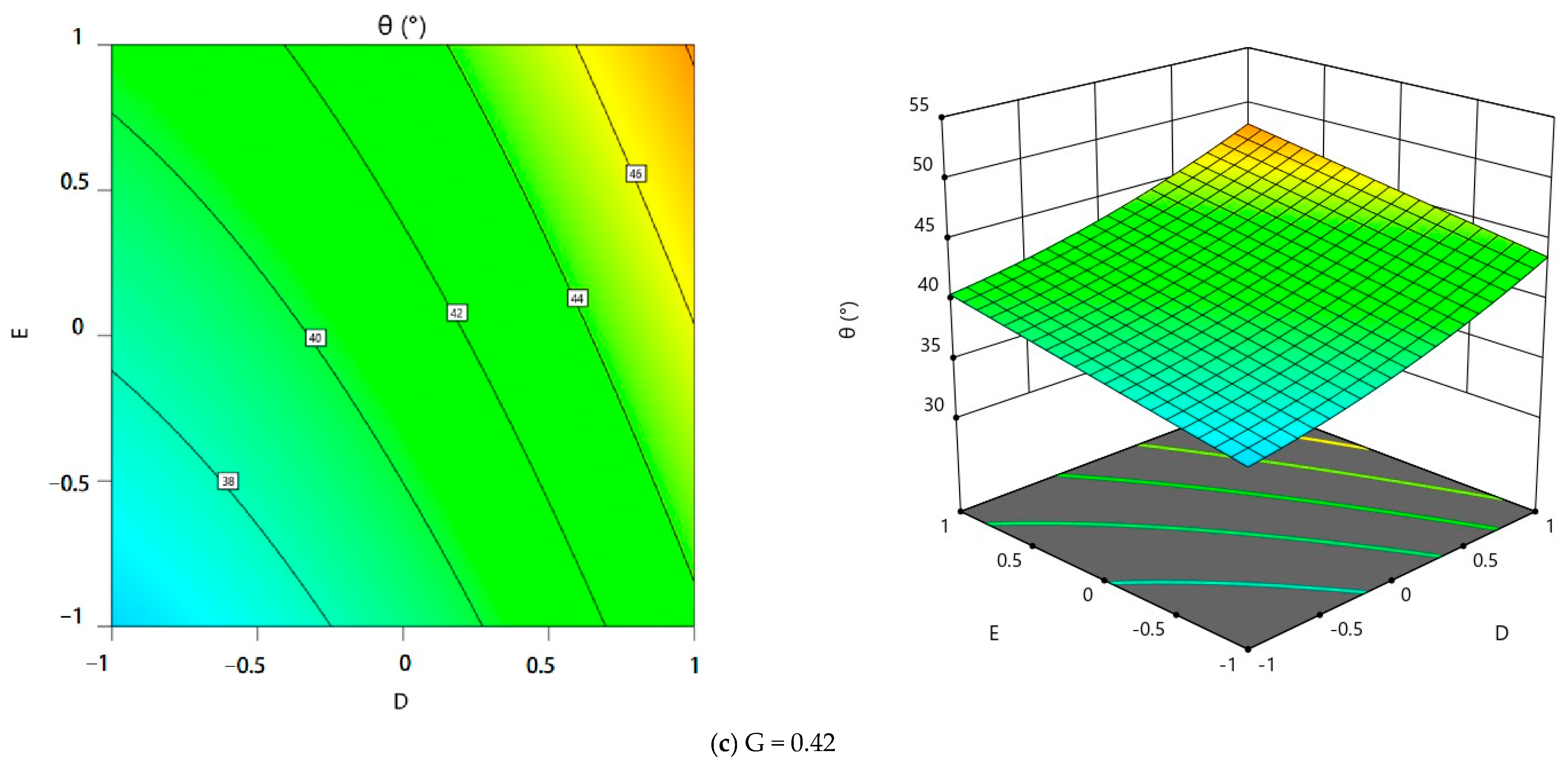
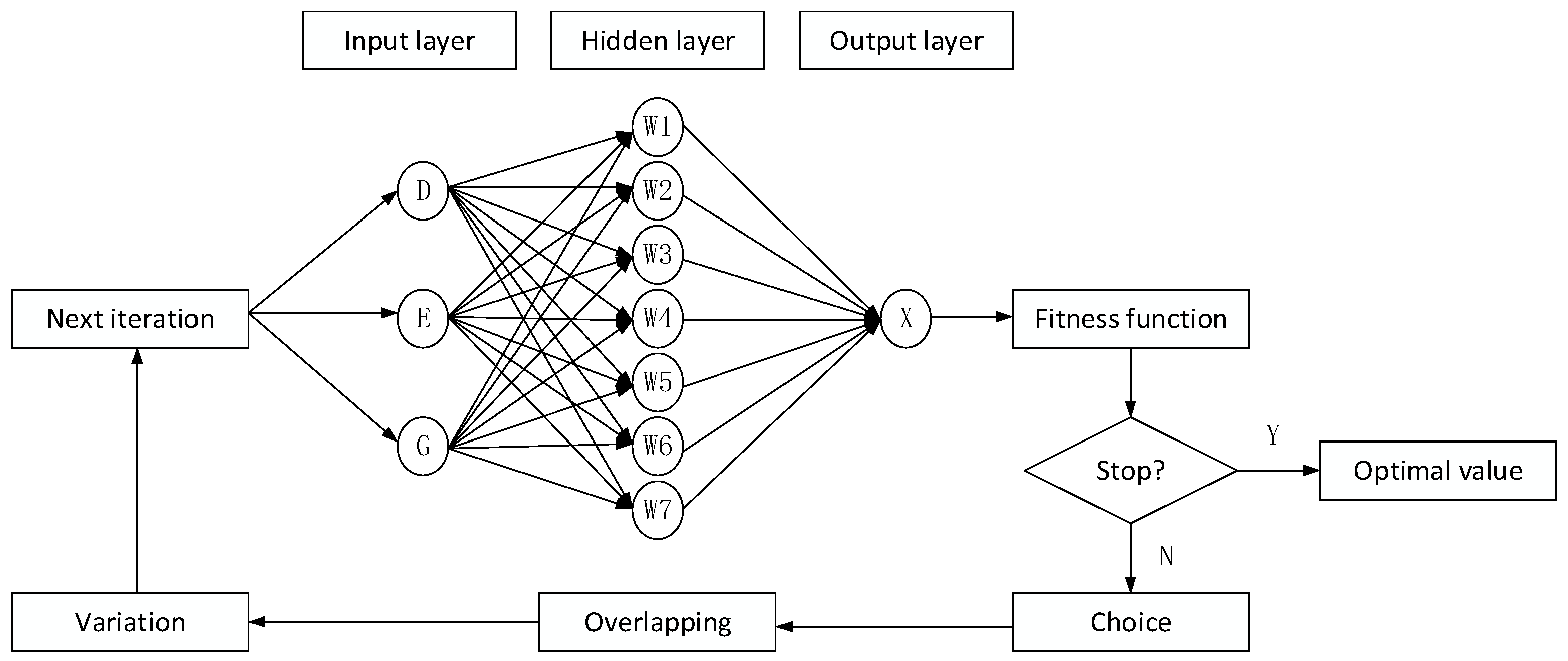
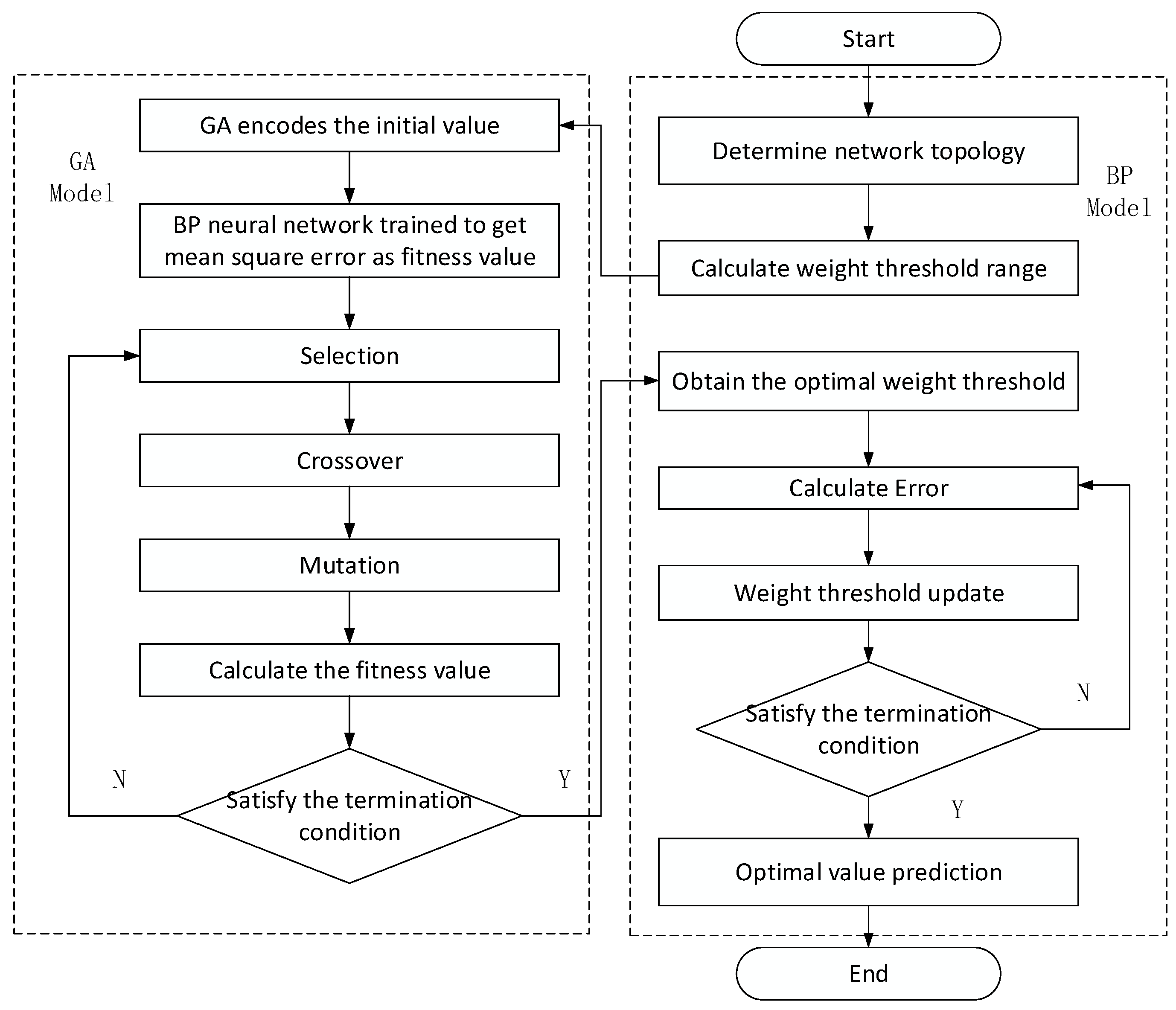
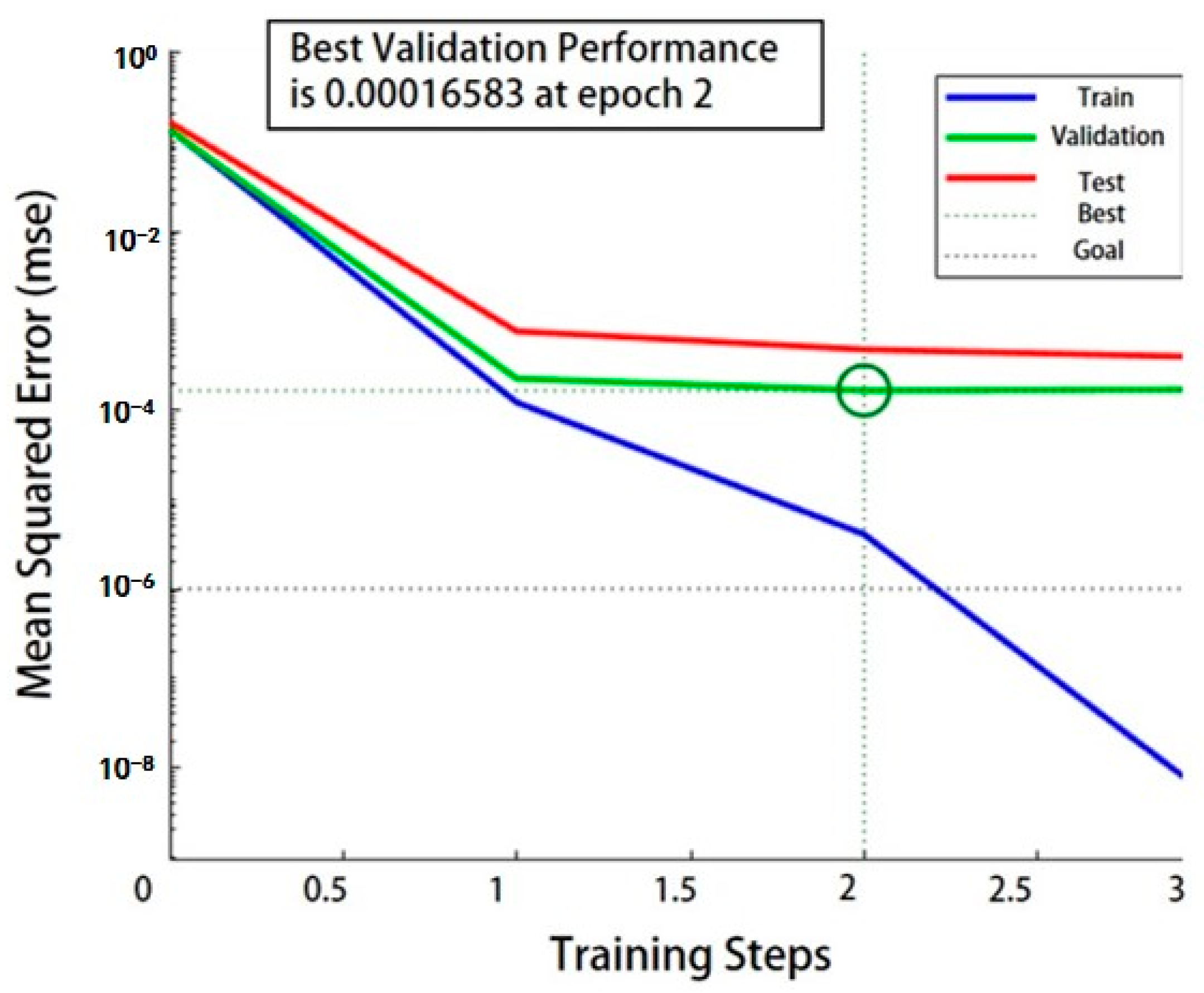
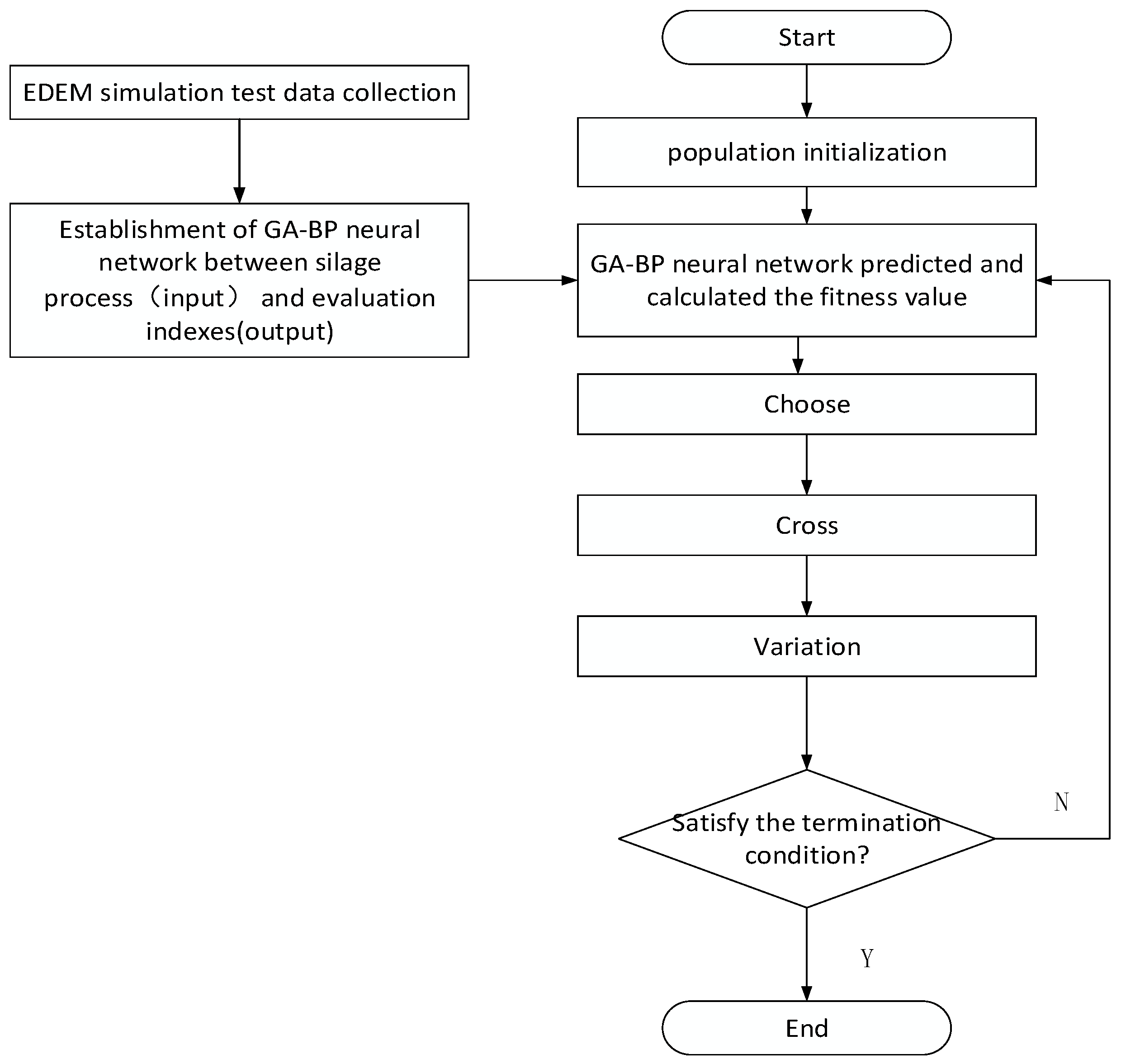
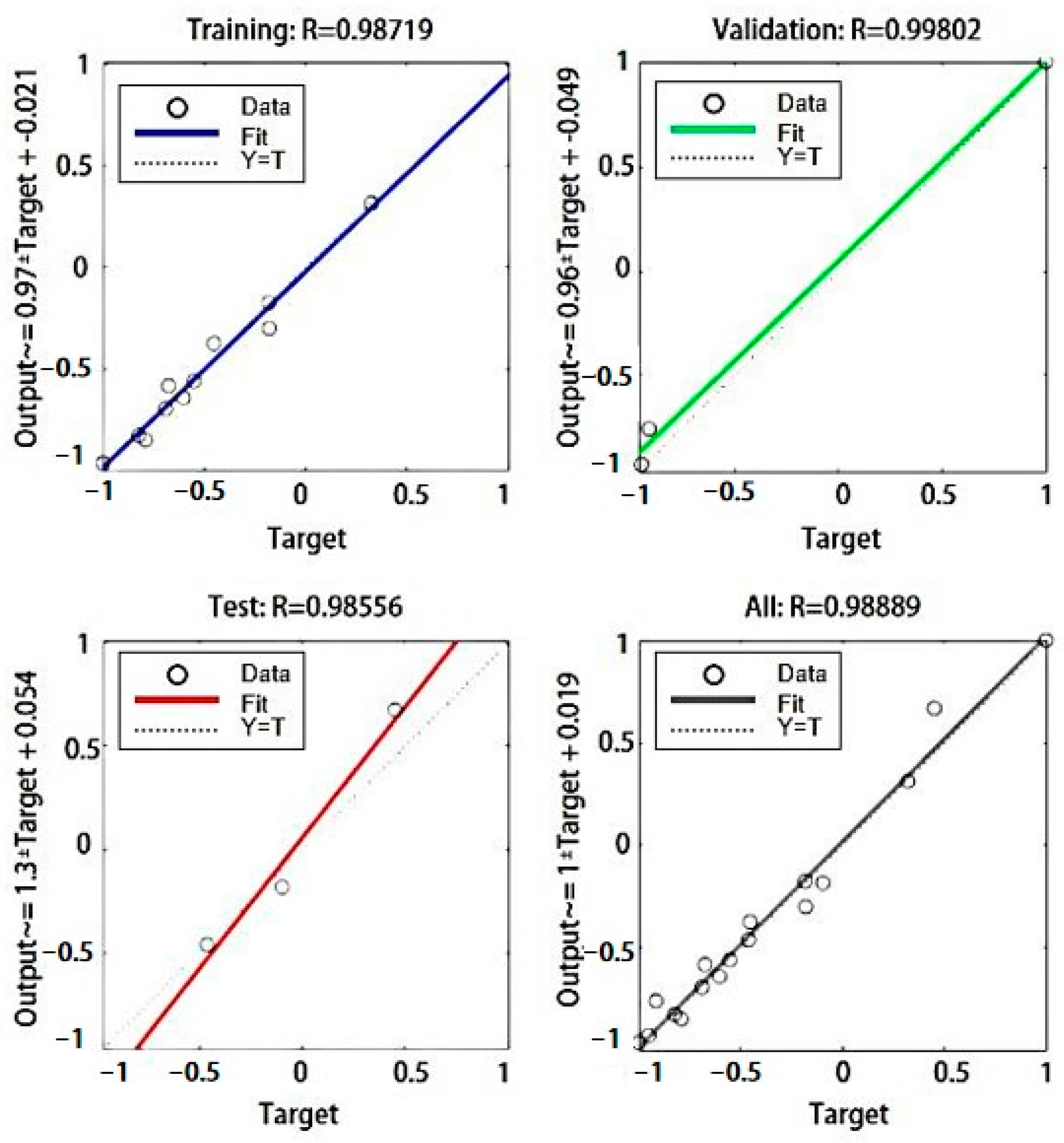
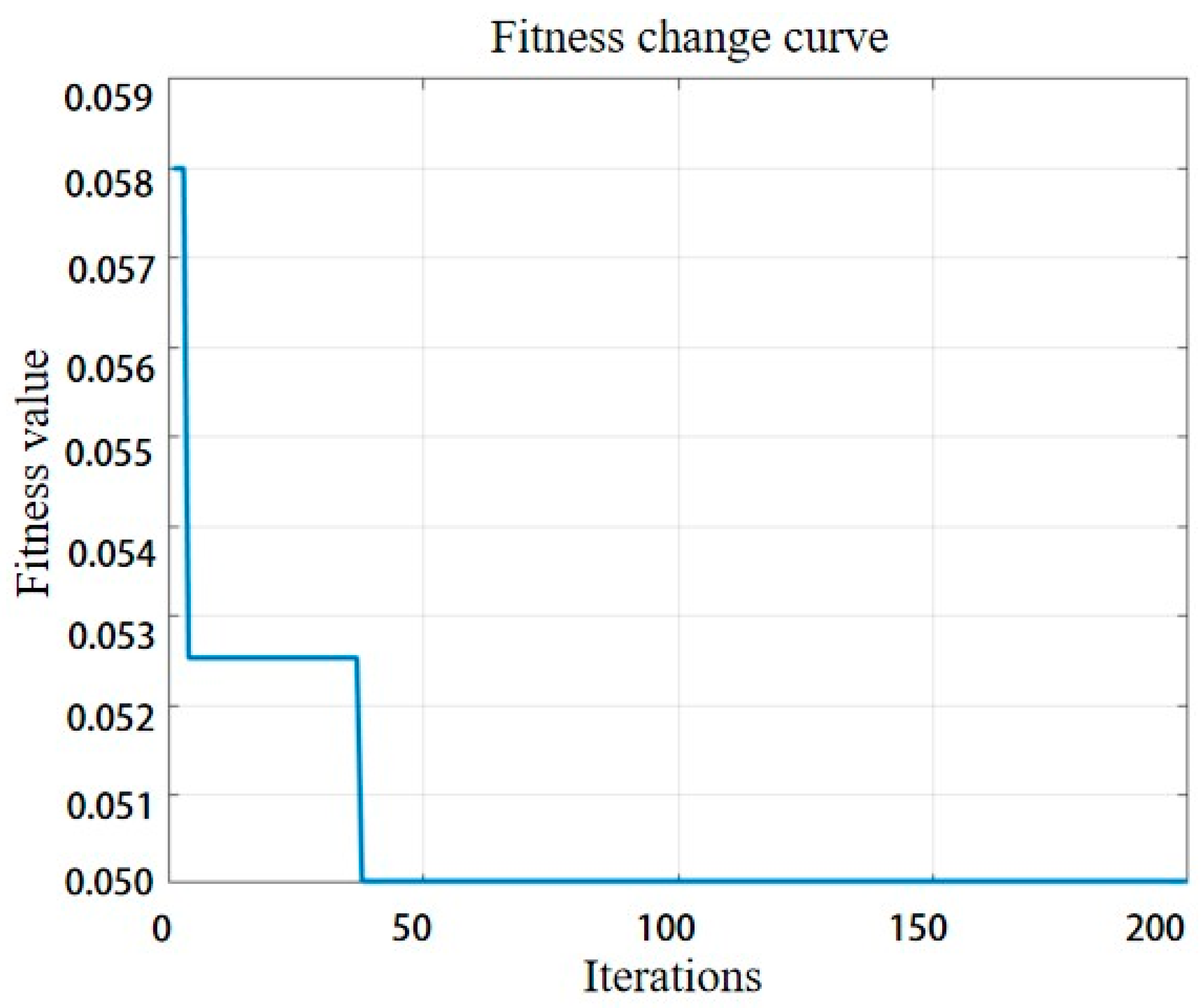

| Sieve Bodies | Upper Sieve Body | Middle Sieve Body | Lower Sieve Body |
|---|---|---|---|
| Size/mm | >19 | 8 ≤ particle size ≤ 19 | <8 |
| Percentage of mass | 13.86% | 47.53% | 38.61% |
| Serial Number | 1 | 2 | 3 | 4 | 5 | 6 | 7 | 8 | 9 | 10 |
|---|---|---|---|---|---|---|---|---|---|---|
| Moisture content/% | 69.23 | 70.12 | 67.36 | 68.23 | 69.56 | 72.33 | 70.28 | 67.36 | 66.72 | 70.36 |
| Serial Number | 1 | 2 | 3 | 4 | 5 | 6 | 7 | 8 | 9 | 10 |
|---|---|---|---|---|---|---|---|---|---|---|
| Bulk density/kg/m3 | 484.7 | 481.5 | 512.3 | 475.3 | 496.5 | 487.5 | 490.7 | 483.6 | 508.2 | 496.5 |
| Serial Number | 1 | 2 | 3 | 4 | 5 | 6 | 7 | 8 | 9 | 10 |
|---|---|---|---|---|---|---|---|---|---|---|
| Stacking angle/° | 39.35 | 36.50 | 38.65 | 35.75 | 37.55 | 40.35 | 42.25 | 39.65 | 36.25 | 40.20 |
| Test Parameters | Low Level (−1) | High Level (1) |
|---|---|---|
| Poisson’s ratio A | 0.3 | 0.5 |
| Shear modulus B/MPa | 10 | 35 |
| Silage–silage collision recovery coefficient C | 0.25 | 0.4 |
| The static friction coefficient between silage and silage D | 0.4 | 0.55 |
| Rolling friction coefficient between silage and silage E | 0.1 | 0.25 |
| Silage–steel inter-body collision recovery factor F | 0.15 | 0.35 |
| The static friction coefficient between silage and steel body G | 0.3 | 0.5 |
| Rolling friction coefficient between silage and steel body H | 0.1 | 0.25 |
| Serial Number | Test Parameters | Stacking Angle/(°) | |||||||
|---|---|---|---|---|---|---|---|---|---|
| A | B | C | D | E | F | G | H | ||
| 1 | 1 | 1 | −1 | 1 | 1 | 1 | −1 | −1 | 38.74 |
| 2 | −1 | 1 | 1 | −1 | 1 | 1 | 1 | −1 | 38.32 |
| 3 | 1 | −1 | 1 | 1 | −1 | 1 | 1 | 1 | 36.52 |
| 4 | −1 | 1 | −1 | 1 | 1 | −1 | 1 | 1 | 42.12 |
| 5 | −1 | −1 | 1 | −1 | 1 | 1 | −1 | 1 | 39.02 |
| 6 | −1 | −1 | −1 | 1 | −1 | 1 | 1 | −1 | 37.36 |
| 7 | 1 | −1 | −1 | −1 | 1 | −1 | 1 | 1 | 40.39 |
| 8 | 1 | 1 | −1 | −1 | −1 | 1 | −1 | 1 | 34.34 |
| 9 | 1 | 1 | 1 | −1 | −1 | −1 | 1 | −1 | 35.32 |
| 10 | −1 | 1 | 1 | 1 | −1 | −1 | −1 | 1 | 36.53 |
| 11 | 1 | −1 | 1 | 1 | 1 | −1 | −1 | −1 | 39.34 |
| 12 | −1 | −1 | −1 | −1 | −1 | −1 | −1 | −1 | 34.13 |
| 13 | 0 | 0 | 0 | 0 | 0 | 0 | 0 | 0 | 38.21 |
| Parameters | Sum of Squares | Degrees of Freedom | Mean Square | F-Value | p-Value |
|---|---|---|---|---|---|
| Models | 63.98 | 8 | 8.00 | 19.03 | 0.0170 * |
| A | 0.6674 | 1 | 0.6674 | 1.59 | 0.2967 |
| B | 0.1610 | 1 | 0.1610 | 0.3831 | 0.5798 |
| C | 0.3434 | 1 | 0.3434 | 0.8171 | 0.4327 |
| D | 6.89 | 1 | 6.89 | 16.38 | 0.0272 * |
| E | 46.93 | 1 | 46.93 | 111.66 | 0.0018 ** |
| F | 1.04 | 1 | 1.04 | 2.47 | 0.2140 |
| G | 5.24 | 1 | 5.24 | 12.47 | 0.0386 * |
| H | 2.72 | 1 | 2.72 | 6.46 | 0.0845 |
| Discrepancy | 1.26 | 3 | 0.4203 | ||
| Total | 65.50 | 12 |
| Serial Number | Factors | Stacking Angle/(°) | Relative Error/% | ||
|---|---|---|---|---|---|
| D | E | G | |||
| 1 | 0.4 | 0.1 | 0.3 | 29.16 | 24.61 |
| 2 | 0.43 | 0.13 | 0.34 | 36.61 | 5.35 |
| 3 | 0.46 | 0.16 | 0.38 | 33.86 | 12.46 |
| 4 | 0.49 | 0.19 | 0.42 | 37.33 | 3.49 |
| 5 | 0.52 | 0.22 | 0.46 | 41.08 | 6.2 |
| 6 | 0.55 | 0.25 | 0.5 | 47.18 | 21.98 |
| Coding | Factors | ||
|---|---|---|---|
| D | E | G | |
| −1.682 | 0.464773 | 0.164773 | 0.386364 |
| −1 | 0.475 | 0.175 | 0.40 |
| 0 | 0.49 | 0.19 | 0.42 |
| 1 | 0.505 | 0.205 | 0.44 |
| 1.682 | 0.515227 | 0.215227 | 0.453636 |
| Serial Number | Factors | Stacking Angle/(°) | ||
|---|---|---|---|---|
| D′ | E′ | G′ | ||
| 1 | 1 | −1 | 1 | 46.65 |
| 2 | 0 | 0 | 0 | 40.32 |
| 3 | 1.68179 | 0 | 0 | 48.35 |
| 4 | 0 | 0 | 1.68179 | 50.02 |
| 5 | 0 | 0 | 0 | 36.83 |
| 6 | −1 | −1 | 1 | 43.72 |
| 7 | 1 | −1 | −1 | 38.78 |
| 8 | 0 | 0 | 0 | 39.87 |
| 9 | −1 | 1 | −1 | 36.96 |
| 10 | −1 | 1 | 1 | 43.78 |
| 11 | −1.68179 | 0 | 0 | 32.56 |
| 12 | 1 | 1 | −1 | 45.84 |
| 13 | 0 | 0 | 0 | 39.52 |
| 14 | 0 | 0 | 0 | 38.51 |
| 15 | 0 | 0 | 0 | 38.12 |
| 16 | 0 | 1.68179 | 0 | 43.12 |
| 17 | 0 | 0 | 0 | 38.35 |
| 18 | 0 | 0 | 0 | 40.98 |
| 19 | −1 | −1 | −1 | 32.06 |
| 20 | 0 | 0 | −1.68179 | 33.36 |
| 21 | 0 | −1.68179 | 0 | 34.44 |
| 22 | 0 | 0 | 0 | 37.56 |
| 23 | 1 | 1 | 1 | 50.86 |
| Source of Variance | Sum of Squares | Degrees of Freedom | Mean Square | F-Value | p-Value |
|---|---|---|---|---|---|
| Model | 590.10 | 9 | 65.57 | 21.73 | <0.0001 ** |
| D | 199.26 | 1 | 199.26 | 66.04 | <0.0001 ** |
| E | 69.59 | 1 | 69.59 | 23.06 | 0.0003 ** |
| G | 258.26 | 1 | 258.26 | 85.59 | <0.0001 ** |
| DE | 4.98 | 1 | 4.98 | 1.65 | 0.2214 |
| DG | 3.91 | 1 | 3.91 | 1.29 | 0.2757 |
| EG | 7.39 | 1 | 7.39 | 2.45 | 0.1415 |
| D2 | 14.43 | 1 | 14.43 | 4.78 | 0.0476 * |
| E2 | 2.07 | 1 | 2.07 | 0.6857 | 0.4226 |
| G2 | 30.69 | 1 | 30.69 | 10.17 | 0.0071 ** |
| Residuals | 39.22 | 13 | 3.02 | ||
| Misfit | 24.41 | 5 | 4.88 | 2.64 | 0.1073 |
| Error | 14.81 | 8 | 1.85 | ||
| Total | 629.32 | 22 |
| Source of Variance | Sum of Squares | Degrees of Freedom | Mean Square | F-Value | p-Value |
|---|---|---|---|---|---|
| Model | 571.76 | 5 | 114.35 | 33.77 | <0.0001 ** |
| D | 199.26 | 1 | 199.26 | 58.84 | <0.0001 ** |
| E | 69.59 | 1 | 69.59 | 20.55 | 0.0003 ** |
| G | 258.26 | 1 | 258.26 | 76.26 | <0.0001 ** |
| D2 | 14.36 | 1 | 14.36 | 4.24 | 0.0551 |
| G2 | 30.58 | 1 | 30.58 | 9.03 | 0.0080 ** |
| Residuals | 57.57 | 17 | 3.39 | ||
| Misfit | 42.76 | 9 | 4.75 | 2.57 | 0.0996 |
| Error | 14.81 | 8 | 1.85 | ||
| Total | 629.32 | 22 |
Disclaimer/Publisher’s Note: The statements, opinions and data contained in all publications are solely those of the individual author(s) and contributor(s) and not of MDPI and/or the editor(s). MDPI and/or the editor(s) disclaim responsibility for any injury to people or property resulting from any ideas, methods, instructions or products referred to in the content. |
© 2023 by the authors. Licensee MDPI, Basel, Switzerland. This article is an open access article distributed under the terms and conditions of the Creative Commons Attribution (CC BY) license (https://creativecommons.org/licenses/by/4.0/).
Share and Cite
Li, G.; Ma, J.; Tian, X.; Zhao, C.; An, S.; Guo, R.; Feng, B.; Zhang, J. Discrete Meta-Simulation of Silage Based on RSM and GA-BP-GA Optimization Parameter Calibration. Processes 2023, 11, 2784. https://doi.org/10.3390/pr11092784
Li G, Ma J, Tian X, Zhao C, An S, Guo R, Feng B, Zhang J. Discrete Meta-Simulation of Silage Based on RSM and GA-BP-GA Optimization Parameter Calibration. Processes. 2023; 11(9):2784. https://doi.org/10.3390/pr11092784
Chicago/Turabian StyleLi, Gonghao, Juan Ma, Xiang Tian, Chao Zhao, Shiguan An, Rui Guo, Bin Feng, and Jie Zhang. 2023. "Discrete Meta-Simulation of Silage Based on RSM and GA-BP-GA Optimization Parameter Calibration" Processes 11, no. 9: 2784. https://doi.org/10.3390/pr11092784
APA StyleLi, G., Ma, J., Tian, X., Zhao, C., An, S., Guo, R., Feng, B., & Zhang, J. (2023). Discrete Meta-Simulation of Silage Based on RSM and GA-BP-GA Optimization Parameter Calibration. Processes, 11(9), 2784. https://doi.org/10.3390/pr11092784






